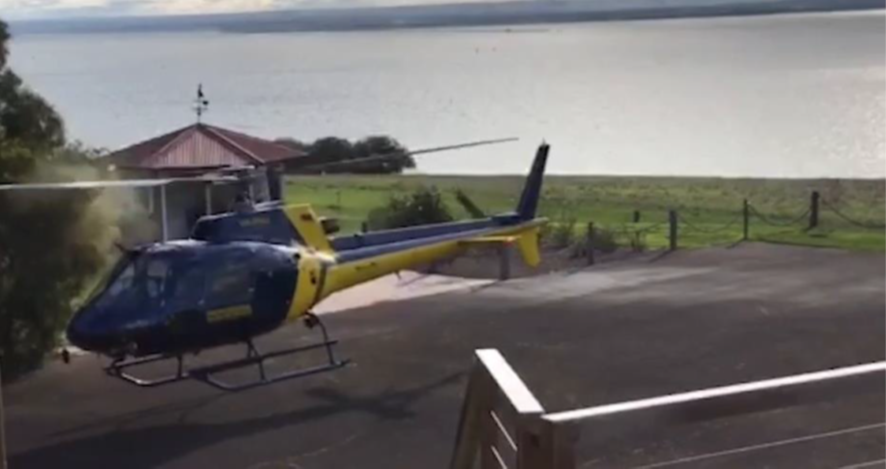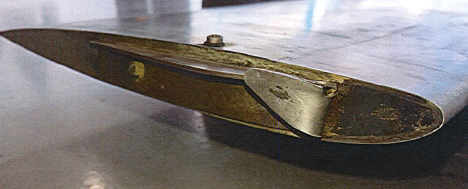What happened
On 4 July 2017, a Eurocopter AS350-BA helicopter, registered VH-PHU and operated by Professional Helicopter Services, was chartered to conduct a flight between Moorabbin Airport and the Jack Rabbit Vineyard helicopter landing site (HLS)[1],[2] on the Bellarine Peninsula, Victoria. At about 1415 Eastern Standard Time,[3] while landing at the HLS, the tips of the helicopter’s main rotor blades struck an encroaching bush (Figure 1).
Figure 1: Smart phone footage of the main rotor blade tip strike (into bush)

Source: Allister Gleeson
History of the flight
At about 1310, the pilot volunteered at short notice to conduct the charter flight to the Jack Rabbit Vineyard. As the pilot had not previously flown to this HLS (a tennis court), he discussed the landing site with another experienced company pilot. Their discussions included consulting Google earth and ascertaining the safest way in and out of the landing site (Figure 2). The pilot also spoke with staff at the vineyard to inform them of his planned arrival and, at their request, confirmed that he would make his approach from the north, so as not to overfly the vines.
At about 1340, the flight departed Moorabbin Airport about 40 minutes later than originally planned. With two passengers on board, the pilot flew south for a scenic coastal flight via Port Phillip Heads, to the Bellarine Peninsula. The reported weather for the flight was for visibility greater than 10 km and a northerly wind at 10-15 kt.
On arrival, the pilot recognised the features of the HLS from his pre-flight planning and conducted a north-to-south, downwind approach,[4] which was appropriate for the conditions on the day.
During the approach, the pilot identified the key boundaries of the landing site, which included a brick wall at the southern end of the site, but he did not see a large bush that encroached into the HLS. When established in the HLS, and believing that he had to make way for another helicopter, the pilot slowly hover-taxied the helicopter forward towards the south‑west corner of the landing site. During this, the pilot reported that he remained focused on the brick wall ahead (Figure 2).
Figure 2: Jack Rabbit Vineyard HLS

Source: Google Maps, modified by the ATSB
At about 1415, the tips of the helicopter’s main rotor blades struck the encroaching bush (now on the helicopter’s right side) (Figure 3). The pilot initially landed the helicopter, then soon after repositioned clear of the bush.
Figure 3: Encroaching bush in the HLS and the main rotor blade strike area

Source: Operator, modified by the ATSB
The helicopter was subsequently shut down and secured without further incident. There were no injuries. All three of the helicopter’s main rotor blade tip caps were found damaged (Figure 4). The sequence of the incident was captured on a smart phone and subsequently reviewed by the ATSB.
Figure 4: Damage to VH-PHU rotor tip caps

Source: Operator
Pilot comments
Aware of the operator’s mantra to ‘not let commercial pressures influence the way you fly’, the pilot was content to fly the charter and felt adequately prepared for the flight. However, the pilot reported that, as the HLS was easily recognisable from his pre-flight planning and due to over‑confidence, he elected to abbreviate the usual 360° reconnaissance[5] of the site. Instead, he conducted a sweeping 270° turn about the HLS, prior to his downwind approach into the landing site. The approach to the centre of the HLS was as anticipated.
Before manoeuvring within the HLS, the pilot ensured that the area around the helicopter was free of obstacles, but acknowledged that he did not notice the bush and how far it encroached into the landing site. The pilot commented that he was focusing on the brick wall as he moved forward and had discounted the right side of the helicopter.
Operator’s investigation
Professional Helicopter Services conducted an internal investigation into the incident and concluded the following:
- The pilot lost situational awareness from focussing on the brick wall during the final stages of the landing sequence and did not ensure adequate clearance from obstacles on the right side of the helicopter.
- The pilot, having recently been cleared to fly advanced manoeuvres, may have felt ‘overconfident’ in his general flying abilities at the time of the incident.
- The operator was not aware that the pilot had not previously landed at the HLS.
- The pilot had mistakenly believed that another helicopter was also required to use the HLS, which was his motivation to hover-taxi.
Safety analysis
The pilot’s confidence in his abilities influenced his decision to conduct an abbreviated reconnaissance of the HLS. This removed an opportunity to observe the encroaching bush. This, combined with the pilot’s focus of attention on the brick wall in front of the helicopter when landing, meant that he was not aware of the bush to his right.
Further, the pilot believed that another helicopter was also landing at the HLS and he elected to hover-taxi to the south-west corner of the site to provide room for that helicopter. However, as the pilot was not aware of the encroaching bush when conducting this manoeuvre, the helicopter’s main rotor blades struck the bush.
Findings
The findings should not be read as apportioning blame or liability to any particular organisation or individual.
- An abbreviated reconnaissance of the helicopter landing site, along with a focus of attention on other obstacles within proximity, resulted in the pilot not being aware of a bush encroaching the helicopter landing site and the helicopter’s main rotor blades striking the bush.
Safety action
Whether or not the ATSB identifies safety issues in the course of an investigation, relevant organisations may proactively initiate safety action(s) in order to manage and mitigate their safety risk. The ATSB has been advised of the following safety actions in response to this occurrence.
Professional Helicopter Services
As a result of this incident, the operator has advised the ATSB that they have taken the following safety actions:
- reviewed internal flight tasking processes
- updated and upgraded internally provided HLS documentation, and provided this information electronically (iPad)
- learning outcomes from this incident are to be incorporated into future practices and disseminated to all pilots and aircrew.
Safety message
This incident highlights the need for a heightened situational awareness by pilots when operating in the vicinity of obstacles as there is very little or no margin to recover from any unexpected event(s). This is particularly important when operating into a confined area and unfamiliar location.
The ATSB publication Avoidable Accidents No.6 - Experience won’t always save you: Pilot experience is not always a protection against an accident highlights that pilots, no matter their experience, are not immune to errors and that experience alone will not protect a pilot from an accident.
Purpose of safety investigationsThe objective of a safety investigation is to enhance transport safety. This is done through:
It is not a function of the ATSB to apportion blame or provide a means for determining liability. At the same time, an investigation report must include factual material of sufficient weight to support the analysis and findings. At all times the ATSB endeavours to balance the use of material that could imply adverse comment with the need to properly explain what happened, and why, in a fair and unbiased manner. The ATSB does not investigate for the purpose of taking administrative, regulatory or criminal action. TerminologyAn explanation of terminology used in ATSB investigation reports is available here. This includes terms such as occurrence, contributing factor, other factor that increased risk, and safety issue. Publishing informationReleased in accordance with section 25 of the Transport Safety Investigation Act 2003 Published by: Australian Transport Safety Bureau © Commonwealth of Australia 2018
Ownership of intellectual property rights in this publication Unless otherwise noted, copyright (and any other intellectual property rights, if any) in this report publication is owned by the Commonwealth of Australia. Creative Commons licence With the exception of the Coat of Arms, ATSB logo, and photos and graphics in which a third party holds copyright, this publication is licensed under a Creative Commons Attribution 3.0 Australia licence. Creative Commons Attribution 3.0 Australia Licence is a standard form licence agreement that allows you to copy, distribute, transmit and adapt this publication provided that you attribute the work. The ATSB’s preference is that you attribute this publication (and any material sourced from it) using the following wording: Source: Australian Transport Safety Bureau Copyright in material obtained from other agencies, private individuals or organisations, belongs to those agencies, individuals or organisations. Where you wish to use their material, you will need to contact them directly. |
__________
- A recognised HLS, when normally situated outside the boundary of an aerodrome, will be generally considered as a confined area, and, as such, will require the use of relatively advanced helicopter procedures and techniques to safely operate into, around and from.
- 9 km west-north-west of St. Leonards aeroplane landing area (ALA).
- Eastern Standard Time (EST): Coordinated Universal Time (UTC) + 10 hours.
- Downwind approaches (when compared to into wind approaches) to any landing site requires the pilot to reconsider their available power, manoeuvrability, handling characteristics, heading control, control limits and wind speed. limitations. During a downwind approach, the higher than normal ground speed/low airspeed condition places the helicopter in a poor situation should it require to overshoot.
- As part of the planning process, a 360° reconnaissance overflight (at various heights) around any landing site affords the pilot a better understanding of the size, shape, surface, slope and surrounds of the landing site. Additionally, pilots will also consider the best way in and out of a landing site noting any obstacles and obstructions. The reconnaissance process is designed to maximise the safety of the helicopter when conducting confined area operations.


